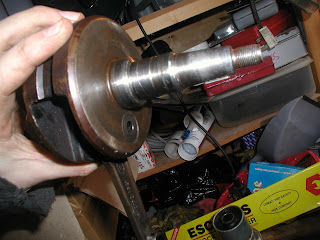Be sure to replace the o-ring on the layshaft. You'd be stupid not to at this point. This photo shows the old one having been cut off and the new one fitted. You can just about see how square and flat the profile of the old one had become.

Tap the layshaft into the rear bearing - you'll feel the resistance when the o-ring goes through. Keep going until the splines meet the bearing as seen here:

Fitting the sliding dog is awkward. Two of its six arms have chamfers on the bottom side, allowing you to slide it down the layshaft while pushing two ball bearings against the end of the spring which goes through the shaft. If you let go of the balls too early they'll fall away from the layshaft and you risk bending your spring if you continue to push the sliding dog down. Basically you need to hold on to the balls as long as you possibly can while sliding the dog down, and then when you must let go hopefully the chamfers should push the balls against the spring into the layshaft. Just persevere, you'll get there.
Prior to fitting the gear selector wishbone, I replaced the selector pins or 'pawls' as MB call them. This photo shows how much the old ones (shown still fitted) had worn:

After the selector is in, install the gear cluster bearing then the gear cluster, not forgetting the shim in between. Then install all the gears onto the layshaft and at the top place the small shim and the needle bearing - both of these I bought new.
Now for the large gear shim - this separates the gearbox end plate from first gear and is available in a multitude of sizes. MB Developments go from 1.8mm to 2.8mm, and
Fanatic sell 4.4mm ones! To work out which size shim you need, fit the gearbox end plate and the rear hub (or at least the hub nut with a spacer tube to replicate the fitting of the hub), and with a feeler gauge measure the space between the end plate and first gear. The ideal distance is somewhere between 0.07 and 0.3mm. I have to say I'm not convinced fully tightening the rear hub is necessary; as long as the splines on the layshaft are fitted right up against the bearing then there's not much here to compress when tightening the hub nut - no gaskets or seals etc. Don't take
my word for it though.
My old shim was ridged and worn, so it was near impossible to take a correct reading. You can see the wear here:

This caused play of considerably more than 0.6mm. I couldn't measure exactly how much because you have to bend your gauge to reach the right bit, and bending anything more than 0.6mm into this space is a little tricky. My existing shim was a 2.26mm, but the worn groove on both sides looked like I'd lost at least 0.5mm of this. With hindsight I shouldn't have even bothered measuring it with this shim as it clearly needed replacing. I bought some replacements from MB advertised as 2.0, 2.2 and 2.4mm, but actually measuring 1.96, 2.27 and 2.44mm:
Before fitting the end plate a new gear cluster bearing (6004 SKF) was installed using the old one as a drift. Here's a photo of it prior to the large circlip being installed:

And I can't carry on without showing you a pic of the gearbox before putting the lid on:

For some reason I really hate nuts and studs, so to secure the endplate I used spring washers (from
Screwfix) and bought some hex set screws (which your everyday man on the street would call a 'bolt') from
MB, part number
MBFH7X25SC to precise. Their website says "Amongst many applications this fastener can specifically be used to secure the gearbox endplate".
Unfortunately they're too long for my casing. The middle screw in this photo is wound in as far as it would go:

Perhaps the holes are shallower in an Indian casing, or mine was from a dodgy batch in the factory? Either way, where needed I cut the screws down to the right size with a hacksaw - none of them ended up being shorter than the standard studs that were fitted previously. Some of them I didn't need to cut, meaning that my holes are variable! Whenever you cut a bolt/screw always put a nut on first and cut below the nut. Then when you take the nut off it will remove any thread damage or burr that the saw created that might make inserting it difficult.
When fitting the end plate make sure it slides on squarely onto the gear cluster, and tighten each bolt a little at a time.
I ended up using the 2.44mm shim and measured a healthy clearance of under 0.27mm. Job done:




















